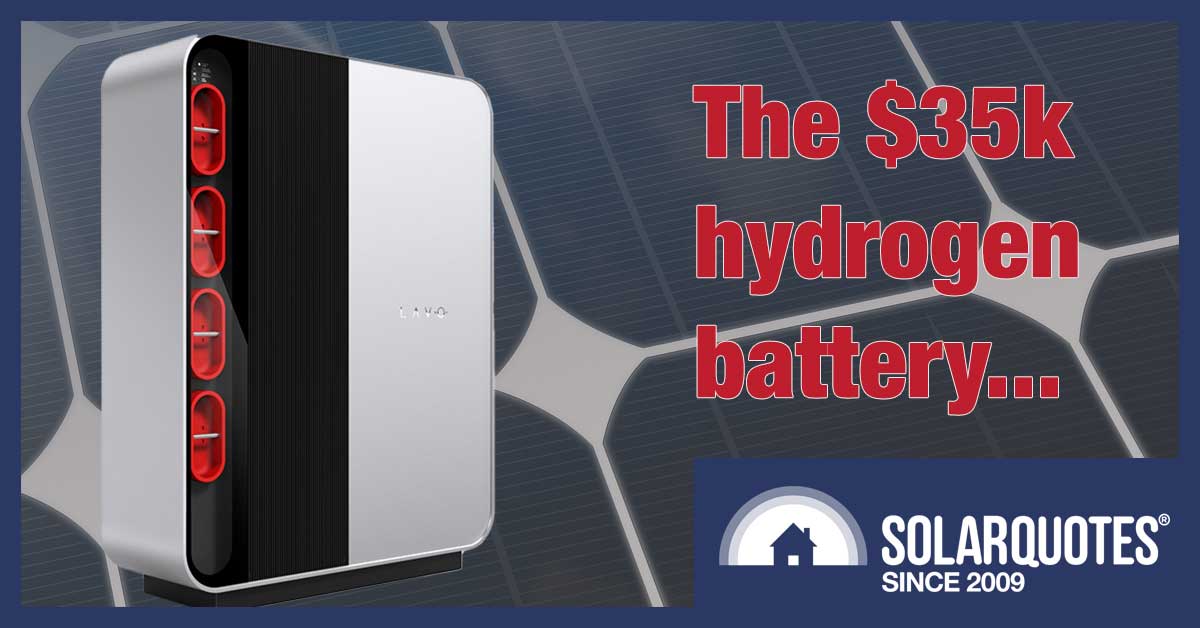
The LAVO hydrogen battery is a feat of engineering -but who will buy it?
If all you’ve ever wanted out of life is to own an Australian made, hydrogen-powered, fuel cell, energy storage system then I have some really good news for you. In October, Australian company LAVO launched a hydrogen energy storage system for homes and businesses. While it’s mainly a fuel cell, they refer to it as a hydrogen battery, so if you want to call it a battery knock yourself out.
In case this news has made you too excited to read complete sentences, here are a heap of bullet points on its main features:
- 40 kilowatt-hours of energy storage.
- 5 kilowatts of power.
- Around 50% efficiency.
- Requires a separate hybrid inverter.
- Requires a water connection.
- Annual professional maintenance will be either required or recommended.
- 10-year warranty.
- It’s 324 kg and is around the size of a large double fridge.
- It requires outdoor installation
- First units available June 2021.
- The price is $34,750.
I’m really impressed with LAVO’s technology. If you told me a few months ago a hydrogen energy storage system would be ready for residential use by the middle of next year I would have scoffed at the idea. I would have scoffed hard. But LAVO has managed to cram a hydrogen fuel cell storage system into a surprisingly small massive cabinet.
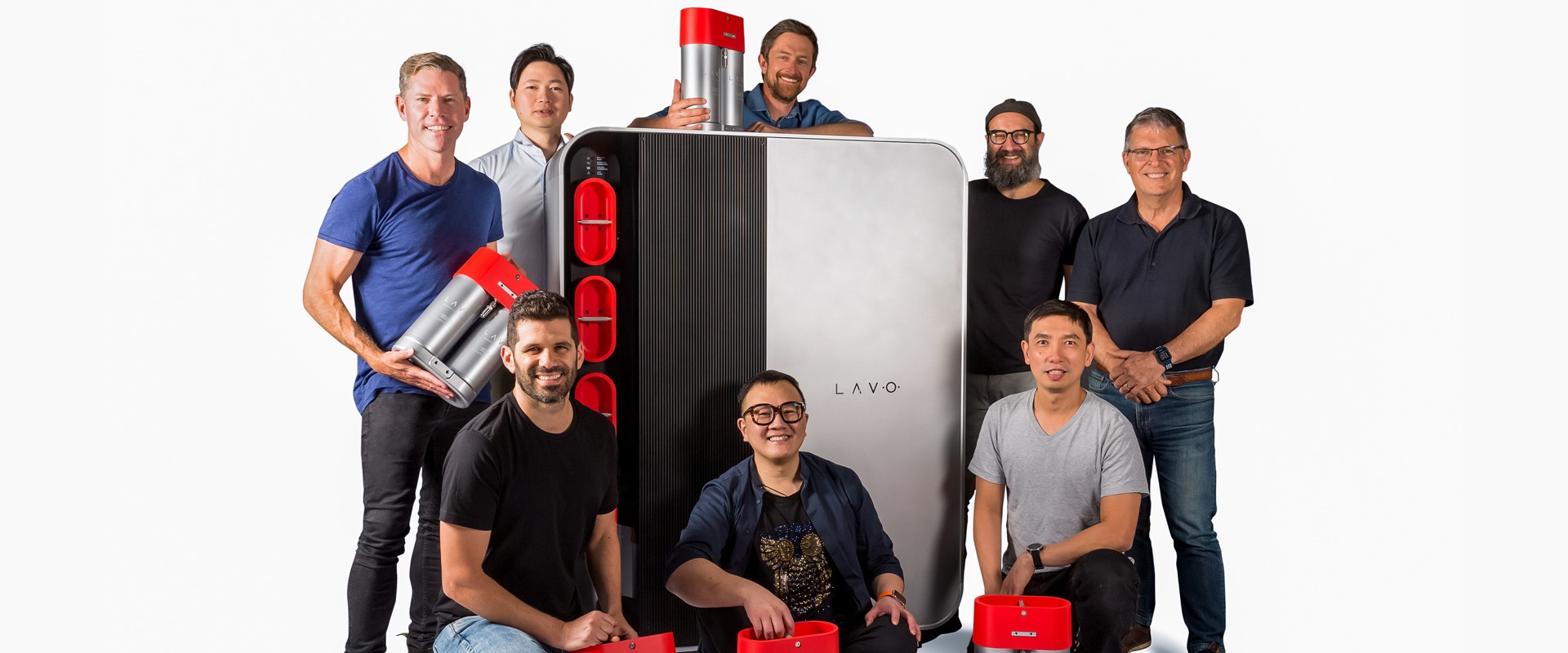
The incredibly talented team behind the massive LAVO. And a few in front too.
The bad news is, I don’t see how it can compete with battery storage. Unlike lithium batteries, it may suffer little or no deterioration in capacity over time, but this advantage will often be outweighed by its far lower energy efficiency. It’s also more complex to install, requires more maintenance, its power output is limited to 5 kilowatts, and its 10-year warranty length is fairly typical. The cost per kilowatt-hour doesn’t compare badly with lithium batteries, but because it stores 40 kilowatt-hours the cost per unit is high. The price will be reduced by 15% in September 2022, but I doubt that will be enough to make it competitive.
While I can think of some applications where hydrogen fuel cells may be the bee’s knees, I think LAVO will have a hard time selling residential units in this country once all the hydrogen enthusiasts have one. But if you want an energy storage system made in Australia, this is definitely an option. Another option would be to load up on Century lead-acid batteries. They will be more energy efficient.
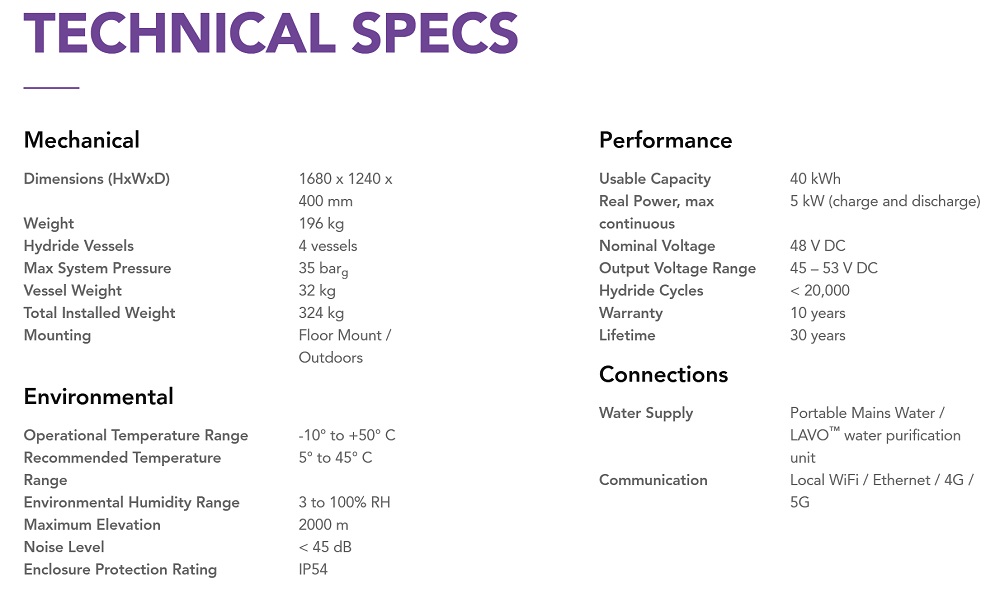
Some technical specifications of the Lavo Energy Storage System.
What The Hell Is LAVO?
LAVO is an Australian company that developed their hydrogen storage system with the help of the University of New South Wales. The fuel cell was developed by Nedstack in the Netherlands but will be made here. Manufacturing will be done by Varley, a large Australian engineering firm, in Australia.
LAVO says they will create 1,400 jobs in Australia by 2025. I wish them luck, but I will note that when new companies say how many people they intend to employ in the future, they often pick a number that will get politicians on their side rather than one that is connected to reality.
What’s In A Name?
LAVO is named after Antoine Lavoisier who was an 18th century Frenchman who married a 13 year old and was a member of the fermiers généraux. This was a group in charge of beating people up and taking their money so the King could buy wigs. In 1794 Lavoisier was executed for the crime of adding water to tobacco. He was exonerated 18 months later but by then it was too late, as very few people manage to live even 17 months after having their heads cut off.
Fortunately for his place in history he was also a great humanitarian and a kick-arse chemist, with his wife making a considerable contribution to their intellectual output. In 1783 he gave hydrogen its current name. This was a good thing, as the English term was “inflammable air” and there are far too many people these days who think “inflammable” means “not flammable” for the old name to be consistent with safety.

Here we see Lavoisier showing off his one sexy leg in an attempt to start some chemistry. (He had two legs. The other one just wasn’t that hot.)
Lots Of Energy — Not So Much Power
The LAVO Energy Storage System, or LESS for short, can provide 40 kilowatt-hours of stored electrical energy. This is far more than most residential battery systems and around three days average electricity consumption for a typical home. But if you were hoping to use a LESS to go off-grid I’ll warn you it can only provide 5 kilowatts of power, which is not enough to lead a normal on-grid lifestyle. You can have extra power by getting another LESS but that will cost more.
The higher the power output the more value an energy storage system has to a Virtual Power Plant, or VPP. This means that, despite its large energy storage capacity, the LESS won’t have a huge advantage when it comes to making money from a VPP compared to something like a Tesla Powerwall 2, which also can provide 5 kilowatts of power but only has one-third the energy storage capacity when new.
Hybrid Inverter And Water Connection Required
The LAVO Energy Storage System requires a hybrid solar inverter to operate. A list of compatible inverters will be released in the future. Unless you happen to have one installed and ready to go it will be an additional cost.
LAVO says it has been tested with a Sungrow SH5K-20 inverter. This is a 5 kilowatt hybrid inverter that can provide a maximum of 3 kilowatts of power from the LESS.
A water connection is also needed because the system works by splitting water into hydrogen and oxygen. It stores the hydrogen and lets the oxygen blow away. If town water isn’t available it will need to be connected to a water pump. The system has its own built in water purifier.
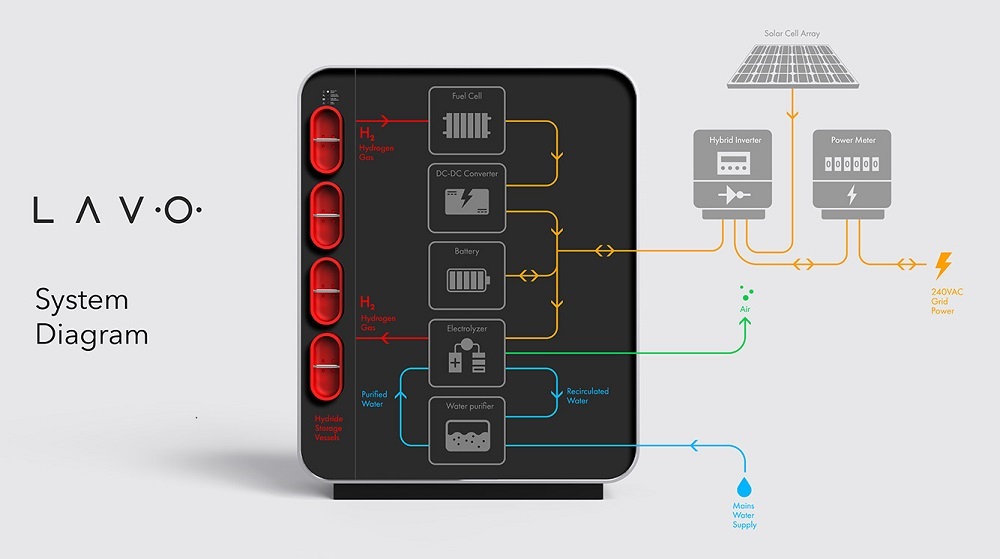
This diagram shows the how the LAVO Energy Storage System uses power from a hybrid inverter to split ordinary tap water into hydrogen and oxygen.
Overall Efficiency May Be Under 50%
In this screenshot from their website LAVO says the round-trip efficiency of the LESS is over 50%:
Round-trip efficiency includes both:
- energy lost creating hydrogen and
- energy lost using hydrogen
…as well as any other losses involved in running the system.
Over 50% is exceptional for small scale hydrogen storage. Its fuel cell was created by Nedstack and on this page they say the maximum efficiency of their current fuel cells when generating electricity from hydrogen is only 56%:
By my understanding, if it was the same for the LAVO Energy Storage System its round-trip efficiency would have to be considerably less than 50% due to hefty energy losses from creating hydrogen. This suggests the LAVO must have an even higher efficiency fuel cell inside.
This is certainly not something I would have expected in a residential hydrogen storage system at this time.
Because LAVO doesn’t say how far its round-trip efficiency is over 50%, I’ll assume it doesn’t beat it by much. Because there will be small losses from the hybrid inverter, I expect the total efficiency from the solar panels to hydrogen storage to household electricity will be under 50%. This means more than 2 kilowatt-hours of electricity will need to be provided to the LESS for each kilowatt-hour of stored energy output.
This compares very poorly to Lithium batteries which can have an overall efficiency above 90% when used with a hybrid inverter.
Efficiency Will Probably Decline
Over time the efficiency of fuel cells will usually decline, although this can happen very slowly. LAVO doesn’t give any information on this but, with regard to their existing fuel cells, Nedstack states…:
“During the life of the fuel cell the electrical efficiency will decrease.”
They don’t say by how much, but they do say they can operate for over 20,000 hours before “refurbishment”.
Water Use
With 50% efficiency, it would take at least 338 ml of water to make enough hydrogen to provide 1 kilowatt-hour of electricity. LAVO says it will actually use around 450 ml of water per kilowatt-hour. This is a lot because water will be created when the fuel cell produces electricity. This is probably because water is lost due to the considerable heat the unit generates. I’m guessing the LESS relies on water evaporation for cooling, which could increase its water use in hot weather.
It Will Get Hot
The LAVO Energy Storage System’s operating temperature is from negative 10 to 50 degrees Celsius. As long as these figures are for ambient air temperature, that’s a very suitable range for Australia. But the system itself will produce a lot of heat. If the LESS is around 70% efficient when it comes to providing stored energy — which it will need to be to meet its stated round-trip efficiency of over 50% — when it provides its maximum electrical power output of 5 kilowatts it will also produce around 3.5 kilowatts of heat. This is around the output of two room space heaters at full power. However, as a lot of the heat is likely to be carried away by evaporating water, its apparent heat output should be considerably less.
The heat and water vapour output should be taken into consideration when deciding where to locate it.
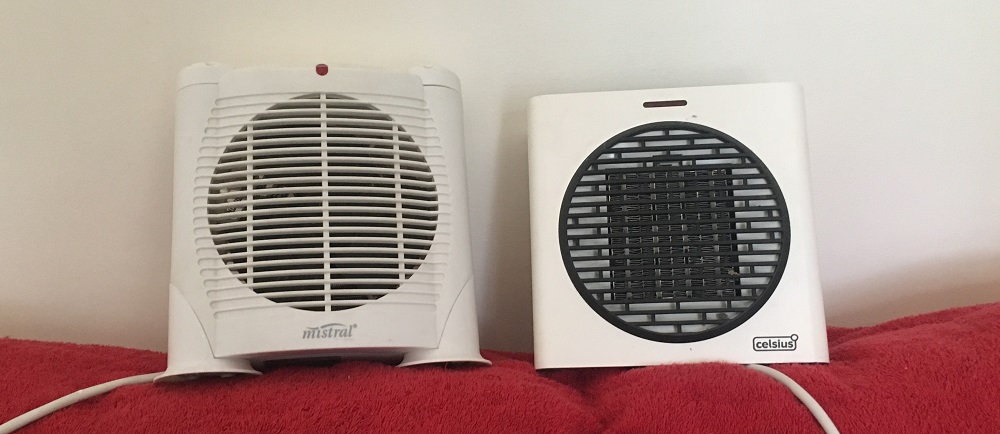
By their power combined, these two bad boys can only put out a maximum of 3.5 kilowatts of heat and that’s provided I don’t pop a circuit breaker. They are dusty because using them kicks both the planet and my finances in the gonads.
It’s Not Loud
LAVO says it produces under 45 decibels of noise. That means it should make about as much noise as a fridge when it’s running.
If you’re wondering what noise you should make when you say the word LAVO it’s Lah-vwah, since it’s named after Lavoisier. But if that seems a bit pretentious, you could just call it what the people from the actual company do, which is La-voh. This includes a French guy.
Outdoor Installation
The LESS is made for outdoor installation. Presumably, this is to prevent any possibility of leaking hydrogen1 building up near ceilings and giving tall smokers a surprise. Outdoors any leaks should rapidly dissipate, as hydrogen is lighter than air.2
The system is large at 168 cm high, 124 cm across, and 40 cm deep. The space required is greater than that as it needs at least 50 cm clearance on either side and 35 cm clearance above. It also has to be located away from where it could be hit by a vehicle.
Its Ingress Protection Rating is IP54 and this should provide protection against rain, but don’t spray it with a hose to clean it off. I would want it in a reasonably sheltered location out of the sun.
Its total installed weight is 324 kg, so no one is likely to pick it up and stroll away with it.3
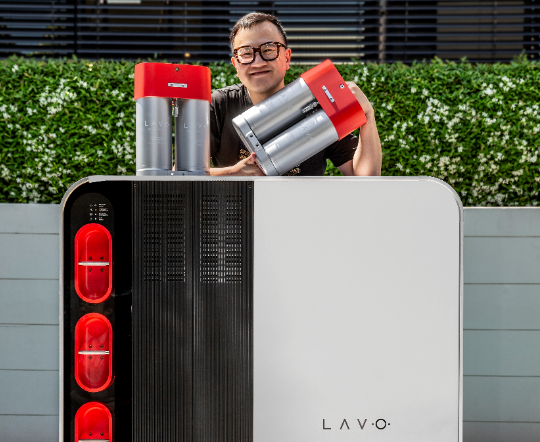
The CEO of LAVO, Alan Yu, holding cylinders that store hydrogen in metal hydride. Because the LAVO Energy Storage System is 168 cm high, he is either standing on a box or very good at supporting his weight with his elbows.
Installation Cost Is Unknown
There is no mention anywhere on the LAVO site that the $34,750 price covers installation. As this can involve the laying of a concrete slab to support its weight and requires an electrical and a plumbing connection, the additional cost could be considerable and may come to thousands of dollars.
Yearly Professional Maintenance
LAVO says yearly professional maintenance will either be required or recommended. This could be a significant additional cost and over a decade could come to thousands of dollars.
A 10 Year Warranty
The LAVO Energy Storage System will have a 10 year warranty. No details are available as the document hasn’t been created yet. We don’t know if there are any limitations on use, if yearly servicing will be part of the warranty conditions, or how much capacity deterioration — if any — it will allow.
They Unwittingly Gave It A 30 Year Warranty
While they say its warranty is for 10 years, LAVO has unwittingly given their system a 30 year warranty by stating that it has a lifetime of 30 years:
I’m no lawyer, but my understanding is if you tell customers a product has a lifespan of 30 years then you have to goddamned make sure it lasts 30 years and are on the hook for providing repairs, replacements or refunds for that length of time. According to Australian Consumer Guarantees, products must…
So if I was a customer I’d be saving copies of all of LAVO’s promotional material where they say or suggest it will last longer than the 10 years its warranty promises to show in small claims court or before a consumer tribunal. And if I was LAVO I’d be changing that information pretty damn quick.

Deals like this are exactly why we have Consumer Guarantees.
Stored Hydrogen Is Mostly Harmless
When fully charged the LAVO Energy Storage System will store enough hydrogen to provide 40 kilowatt-hours of electrical energy. This represents around 57 kilowatt-hours of heat energy if it were to catch fire or explode. This is the energy content of six litres of petrol, which is more than enough to start an out of control fire.
But if the system is properly designed and manufactured, which I’m sure it will be, the danger is minimal. Many of us regularly drive around in vehicles that often have over 50 litres of petrol or diesel in them. We’re fine with this because safety precautions minimize the risk. Hydrogen stored in a LAVO system should be safer than petrol stored in a fuel tank because it is held in a metal hydride that will slow its release if the storage units are punctured.
Using metal hydrides to store hydrogen is something that has been done for a long time and is a proven technology. This very old video shows a guy shooting hydrogen hydride cylinder with a rifle:
https://www.youtube.com/watch?v=QiD7thxC9UQ?t=104s
The cylinder does not explode when shot. It does leak hydrogen and there is flame but it’s hard to see in the video until it is used to set a piece of paper on fire4. The difficulty of seeing hydrogen flames is a danger, so if your hydrogen storage system somehow becomes damaged, please don’t touch it.
If hydrogen leaks without catching on fire then, provided the system is outside, it will harmlessly rise into the atmosphere. There should only be a risk of an explosion if the hydrogen can get trapped under something and build up.
When charging at full power, it will produce around 1,150 litres of oxygen per hour which is released into the air. A high concentration of oxygen increases fire risk but, as this is less than one-third of a litre per second and should rapidly disperse, I assume there’s not much risk of it contributing to a fire.
LAVO Says Batteries Have Short Lifespan
The LAVO site says batteries have a relatively short lifespan and gives a figure of under 5 years:
This is an odd statement because modern batteries used for home energy storage usually have a 10-year warranty. The same length as the LAVO Energy Storage System’s warranty.
It Contains A 5 Kilowatt-Hour Battery
The LAVO Energy Storage System contains a 5 kilowatt-hour lithium battery. Because the fuel cell is slow to react and takes time to warm up, the lithium battery provides a quick response. This means the LESS isn’t a hydrogen energy storage system, it’s a combined hydrogen fuel cell and lithium battery storage system. So there’s more to the LESS than meets the eye.
While they don’t have a good opinion of the lifespan of batteries, LAVO says they expect their battery to last 10-15 years:
If asked, they may claim this is because their battery won’t be used so much.
Presumably, the 5 kilowatt-hour battery means the system only stores enough hydrogen to provide around 35 kilowatt-hours of electricity. But because LAVO says, or at least strongly implies, that it has 40 kilowatt-hours of hydrogen storage I’ve used that figure in this article.5
While storing hydrogen should not be dangerous, both the lithium battery and the hydrogen fuel cell contain flammable6 plastic that could potentially release more thermal energy if it caught on fire than the stored hydrogen. This is unlikely to occur, but does mean using hydrogen doesn’t give the LESS an intrinsic safety advantage over a lithium battery system.
Its Efficiency Is Low
A lithium battery connected to a hybrid inverter can have an overall efficiency of 90% or higher. Due to losses from the hybrid inverter, the overall efficiency of the LAVO Energy Storage System may be under 50%. A 90% efficient battery system will require 1.11 kilowatt-hours to provide one kilowatt-hour stored energy while a 50% efficient LAVO system will need 2 kilowatt-hours. This low efficiency is a major problem.
If a home has a 90% efficient battery system while another has a 50% efficient LESS and they share these characteristics:
- They fully charge their energy storage with solar energy every day.
- They use 10 kilowatt-hours of storage every night.
- Their solar feed-in tariff is 10 cents.
Over 10 years the home with the LESS would receive $3,250 less solar feed-in tariff. So installing a LESS means less money off your electricity bills.
LAVO Energy Storage Requires A Lot Of Solar
In reality, it will be difficult for many homes to keep a LESS fully charged unless they have a very large solar power system. In Sydney, a 6.6 kilowatt north-facing solar system will only generate an average of 16.9 kilowatt-hours a day during May. If the home used 10 kilowatt-hours at night and zero kilowatt-hours during the day, allowing all the solar energy produced to charge the LESS, it would not be able to store enough energy to meet night-time energy use. Even if it started the month fully charged, its buffer of extra stored energy would be gone within three weeks.
As every normal home uses some electricity during the day the actual situation would be worse than this.
It’s Worse For The Environment Than Batteries
The more solar energy homes and businesses export the more fossil fuel based electricity generation is reduced. Because low efficiency will decrease the amount of clean solar energy a home can export, the LESS is a worse choice for the environment than a lithium or other battery when exporting to the grid is an option. For homes that are off-grid or zero export limited this is less of an issue.
It’s Expensive
The LAVO Energy Storage System costs $34,750. Additional costs may include:
- A hybrid inverter.
- Installation.
- Annual maintenance.
- Reduced feed-in tariff.
Even without additional costs, it’s not cheap. For the price of one LESS you could buy nearly 3 Tesla Powerwall batteries, which would have the same total amount of storage, could provide 3 times as much power and with no need for a hybrid inverter, plumbing, or annual maintenance.
Alternatively, Tesla Australia says that for $71,800 you can buy a Model 3 electric car with 75 kilowatt-hours of energy storage. That’s almost twice the energy storage of a LESS for just over twice the price, with the advantage that you can drive it around. While it’s not a direct comparison because you can’t easily take electrical power out of a Tesla car, it is an interesting alternative for what you can do with your money.
A more direct comparison would be to purchase lithium batteries that can also be used with a hybrid inverter. The cost of the LAVO Energy Storage System is enough to buy around 50 kilowatt-hours of these from BYD or another manufacturer. These would have roughly 40 kilowatt-hours of usable capacity. Their efficiency would be far higher and they could provide more power, so long as the inverter can handle it. Provided they are decent quality batteries the warranty should be around the same length when used for home storage.
If you can wait until September 2022 the price of a LESS will be reduced by 15% to $29,450 but I don’t see this as being enough to make it competitive.
Capacity Should Deteriorate Slowly — If At All
Lithium battery capacity deteriorates with use and over time and some major manufacturers’ warranties only promise they will retain a minimum of 60% of their original capacity after 10 years of typical household use. While I expect the capacity of the 5 kilowatt-hour lithium battery in the LAVO Energy Storage System to deteriorate, the hydrogen storage may have no measurable capacity deterioration over its 10 year warranty period. Also, the fuel cell may have no noticeable deterioration in power or efficiency over that time.
It remains to be seen if this will be the case. It is possible for fuel cells to be damaged by contaminants but, as I’ve mentioned, LAVO’s technology is impressive and it’s possible that — when it’s available — its warranty may promise no capacity deterioration.
Stocks Are Limited
LAVO says only 2,500 units will be available from June 2021 until September 2022. They will then produce 5,000 units in the following 12 months, and 10,000 the year after that. Obviously, they have big plans.
If you want to reserve one of the first 2,500 you can go to the LAVO site and put down a fully refundable $250 deposit. In return for letting them hold your money, you will receive absolutely nothing. This is clearly stated in the terms and conditions:
So if you provide LAVO with a deposit to create an obligation for them to supply you with an energy storage system in the future they say they will have no obligation to do so. This is clearly nuts and obviously not what LAVO intends, so they need to fix this.
Competition Will Be Stiff In Australia
Because of its high cost and low efficiency, I think the LESS will have a hard time competing with residential battery storage and this will be the case even if its capacity deterioration is insignificant.
But there could be situations hydrogen energy storage systems are well suited for7. Because fuel cells create a lot of heat due to their relatively low efficiency they can be used to heat water, which could be useful for heating swimming pools. Hospitals also have large water heating requirements and require a supply of oxygen. Currently, the LAVO Energy Storage System releases the oxygen it creates into the air, but it would be possible to capture it for hospital use. There are also industries that require a supply of oxygen and/or hydrogen.
Fuel cells can also be used for home heating and this would obviously be more useful in colder countries. While the LESS isn’t currently capable of heating water or homes at the moment, LAVO may have plans to make models able to do this in the future.8 They may even intend to make most of their future sales overseas to places such as Europe, Canada, and the United States — provided that country’s still around.9 So while it may not sell well here, we can cross our fingers and hope it will be a good little export earner.
If you like the idea of hydrogen storage and making a financial return on energy storage isn’t your primary motivation, then the LAVO Energy Storage System is for you. Put $250 down to pre-order one and receive no obligation at all in return.
Footnotes
- While all hydrogen fuel cells and hydrogen storage systems leak some hydrogen, unless there is a fault the amount should be trivial and safe. ↩
- Unfortunately, leaked hydrogen acts like a greenhouse gas by reducing the rate at which methane — a powerful greenhouse gas — breaks down in the atmosphere. ↩
- If it was fully charged and all the hydrogen it contained was released into a balloon it would be under 1 cubic metre in volume and provide around 1 kg of lift. So no LAVO systems are likely to be balloon launched into the atmosphere. ↩
- Note the hydrogen cylinder contains much less energy in total than the petrol and LPG cylinders they shoot early in the video. They say it contains the same energy, but that’s impossible. ↩
- If you buy a LAVO Energy Storage System and attempt to measure the efficiency of its fuel cell, note the relatively high efficiency of the lithium battery can make the efficiency of the fuel cell appear higher than it is. ↩
- Please use the word “flammable” and toss “inflammable” into the language bin to avoid any possibility of confusion over whether or not something can catch on fire. ↩
- There is considerable military interest in hydrogen because it’s light to transport. This may have something to do with why a major manufacturer of defence hardware will be making the LAVO Energy Storage System. ↩
- Being able to heat water or buildings is not a huge advantage as electrical energy from saved from using more efficient batteries could be used to run a heat pump to provide over three times as much heat in total as a 50% efficient fuel cell. But it has the advantage of not needing a heat pump. ↩
- When I point out to Americans that Donald Trump clearly attempted a coup they say things like, “No, the President’s just grumpy and needs a nap.” Rather than consoling me, this makes me think the situation there is worse than I thought. ↩







 RSS - Posts
RSS - Posts



That low efficiency is terrible for battery economics. Home battery economics are horrible in any case but this just makes it utterly dismal.
I have my battery simulation model so it’s easy to plug in a battery’s specs to see what would happen *in our case*. We have 11kW solar PV and average daily consumption of 38.4kWh including a controlled load of 5.2kWh. Essential Energy zone, NSW.
These are the annual savings (for last 12 months) due to adding a battery based on a Powerwall 2 spec, and the Lavo battery spec (5kW / 40kWh, 50% roundtrip efficiency). I assigned a 5% reserve level for the Lavo (2kWh) and 10% for the PW2 (1.35kWh).
Battery: Annual Saving
Powerwall 2: $348.39
Lavo: $32.42
Yup, my annual bill after installing this $34,000 battery would reduce by $32.
That has to be a first, a battery which will take a millennia to achieve payback!
I don’t see that system as feasible unless it’s right off the grid, and with 2x to 3x the size of battery and hydrogen tank.
Maybe somewhere that the only source of generator fuel is a long canoe trip with a difficult portage.
Or on Mars, could be especially handy there with the extra oxygen and heat.
Hi d Yu ow where in Australia it is made
Thanks Steve
I don’t know, sorry, but since it will be produced by Varley it may be in Tomago.
In the spiel
“Hydride Cycles <20,000"
I presume that means that it can do anything less than 20,000 cycles?
Maybe one or 2?
The engineers may be geniuses but their typist didn't help them with this one.
Chris
Well DOH!.. “Another option would be to load up on xxxxxx lead-acid batteries. They will be more energy efficient.” And MUCH cheaper.
Who’da thought?
Another green hydrogen con job that’s nothing more than a money extraction machine, and a convenient prop for the gas industry.
Seems this made it to the Beyond Zero Emissions “FAST TRACK PROJECTS” list, and picked up some handy government funding to suit.
Yay. Insert slow clap here.
https://treasury.gov.au/sites/default/files/2020-09/115786_BEYOND_ZERO_EMISSIONS_-_SUPPORTING_DOCUMENTATION.pdf
Good catch there, Greg. Thanks for that information.
How on Earth is this thing valued at $2 Billion in that Treasury document?
I have some really exciting propositions that leave this hydrogen battery nonsense for dead. To start with there is this big bridge in Sydney that carries a lot of paying traffic, then there are a few tunnels in Brisbane, a few airports and ports yadda yadda yadda. Only a grubbermunt run by the likes of SCUMMO would consider the hydrogen battery a worthwhile investment.although a coal-fired car would be infinitely more appealing to the COALition. https://www.cnet.com/roadshow/news/gm-coal-powered-turbine-chrysler-leno-ecojet/
I remember when that was suggested for trains. I didn’t know anyone tried it in a car.
They had coal burning vehicles during the 2nd World War.
dRdoS7
Wood burning too. But not a turbine, which is both an impressive and scary way to burn coal.
I think its a great innovation and I hope the company making them continue innovating and getting it more energy and cost competitive.
As an alternative to currently available lithium Iron batteries I think Australia’s very own Redflow Zinc Bromide flow batteries are a good option.
They’re getting cheaper, the tech is improving, aren’t explodey and when the solution inside is spent you just drain and replace it whilst using the spent liquid again by `recharging’ it. (The italics are to to clarify my ignorance and laziness in looking for the correct term.)
I should mention I’m a very small Redflow investor and thats because I think the tech is awesome and has great potential and want to do my small bit in supporting them. I sure as hell won’t be buying an island off those shares. Maybe a small bag of lollies.
These flow batteries cost more per kWh than LiIon batteries and like Lavo also have pretty lousy round trip efficiency, at around 75%. it’s better than the Lavo but these lower efficiency batteries just take battery economics from lousy to abysmal.
They all just cost too much to make much sense. Unless of course your state government decides to throw flipping great wodges of cash at you to buy one.
Great blog, love the humour. If I understood correctly the oxygen is a by-product and dispersed in to the atmosphere. Could it not be collected to offset the cost of this very expensive equipment. For example for hospital/medical use?
That 50% efficiency is both terrible (compared to batteries) and unbelievably good (compared to current hydrogen state-of-the-art). I suspect some of that 50% is optimistic marketing, and/or comes from the built in battery.
If they have really hit 50% efficiency in the hydrogen part, combined with the apparently safe/efficient storage, they’ve made big advances in the technology. Unfortunately the technology still sucks, and particularly for this application.
The one place where hydrogen might start to become viable is for vehicles/aircraft, where you can have separate hydrogen generation infrastructure, so you only need to carry the fuel cell and lightweight hydrogen fuel. It just might be worth paying the terrible efficiency costs for the reduced weight and increased range… but maybe not. Note nearly all electric aircraft in development are ignoring hydrogen and focusing on batteries.
Great tech. Good to hear hydrogen moving forward. It will be the powerhouse tech of the future. But just like all energy innovations there will be old energy powerhouses holding back progression.
At 50% round trip efficiency the stats arnt bad.
For the same price you get three tesla power walls with a combined storage of 39kWh
That’s the same amount of storage but they say this system lasts 30 years 3 times longer then the batteries.
Simple math shows that if the LAVO lasted 20years it would make up for its 50% round trip efficiencies. But because it has another 10years of life, it actually makes it more efficient. Not to mention that its not turning into a massive paper weight once depleted like batteries.
Granted the 5kW output is low and having to use a lithium battery UPS is its weak point.
Fuelcells made today are producing 30kW output. And has a power to weight 10 times greater then lithium batteries. With the most efficient being up around 70% efficient.
Plus when comparing age of technologies. Batteries are ancient.
The more push towards this type of tech the better of we’ll all be.
And in relation to clean hydrogen being a contributor to global warming. I think your getting paid off by the battery companies to make such a claim?? There has only been one model done by UK energy sector and they summarize saying the the environmental risk from a hydrogen economy is small compared to the benefits.
https://www.google.com/url?sa=t&source=web&rct=j&url=https://assets.publishing.service.gov.uk/government/uploads/system/uploads/attachment_data/file/760538/Hydrogen_atmospheric_impact_report.pdf&ved=2ahUKEwj7rPu3tL7tAhWzwjgGHSm7DusQFjABegQIARAF&usg=AOvVaw2zNmfSZuoDDcaIT9Yp5ewg
I’ve been trying to figure out how they could possibly manage 50% round trip efficiency.
I dunno where you get 70% efficiency for fuel cells, everything I’ve read says 40~60% efficiency with a theoretical max of 83%, unless you start capturing waste heat.
Electrolysis efficiency maxes out at 80% efficiency using PEM electrolysis, with a theoretical max of 92%.
Combining these gives you 60% x 80% = 48% efficiency with a theoretical max of 83% x 92% = 76%
And that doesn’t include energy losses in the hydrogen storage part, which can be significant. Some figures say up to 40% of the energy can be lost in storage, with compressors being 70~85% efficient. This system is using low-pressure hydride chemical storage, which I can’t find efficiency figures for. One of the things hydride storage has a problem with is it can require high temperatures to liberate the hydrogen. I’m guessing they re-use the heat from the fuel cell, which maybe explains its slow ramp-up that requires the battery.
So even assuming they somehow get 95% efficiency in hydrogen storage by re-using the fuel-cell waste heat, that gives them 48% x 95% = 45% efficiency. Maybe the extra 5% is in the battery?
Also note that their hydride storage stores 10kWh per 32Kg vessel, or about 0.3kWh/Kg not including the fuel-cell weight etc. Li-Ion is up to 0.26kWh/Kg, so even if their storage is has awesome efficiency, it’s not light enough to be a viable replacement for batteries for eg Aviation.
Hydrogen is released from the units and although it’s a small amount, the “green hydrogen” interacts with methane in the atmosphere and slows it’s natural breakdown which would likely be why it registered some level of environmental risk.
I wonder about this battery, from the following perspectives.
1. What is its Levelised Cost Per Warranted Kilowatt Hour, compared to the following?
As included at
https://www.solarquotes.com.au/blog/zenaji-aeon-battery/
”
My calculations show, for batteries and their Levelised Cost per Warranted KiloWatt Hour,
Tesla Powerwall 2 – 30.5 cents
LG Chem RESU 10 – 32.76 cents
(the full size, 13.5 kWh RESU 13.5 was missing from the SQ battery comparison table)
BYD B-Box Pro 13.8 – 24.34 cents
DCS PV 13.5 – 24.46 cents
and, for the Zenaji battery, as mentioned above, 24.51 cents.
…
As I have stated elsewhere, my calculated values for the Levelised Cost per Warranted KiloWatt Hour, for the batteries, relate only to the purchase price of the batteries, and, do not take into account, delivery and installation, or the price of associated required inverters.
”
(a comparison, involving, in the calculations, installation and maintenance costs, would be useful, for a system of batteries with at least the same usable capacity as the above mentioned battery; e.g., 4 x Tesla Powerwall 2’s, 4 x LG Chem RESU 10’s (note – these are not the model apparently subject to the safety recall in the USA – the high voltage model is the one subject to the safetuy recall), and/or 4 x LG Chem RESU 13’s, 4 x BYD B-Box Pro 13.8’s (and/or 3 x BYD LVS 16.0’s (which have outdoor installation rating) ), and, 3 x DCS PV 15’s (see https://www.deepcyclesystems.com.au/product/pv-series-hybrid-off-grid/ ) ), and, the battery (for which, no prices or costs are stated, in the published information) described at https://www.pv-magazine-australia.com/2020/11/23/interest-grows-in-going-with-the-vanadium-flow/ ; “a 5 kW/30 kWh VRFB with a maximum discharge of 7 kW”)
2. How does the expected performance of the LAVO system, compare with each of the (approximate) equivalents in the preceding paragrah?
3. What is the expected effect of the LAVO hydrogen based system, in an Australian wildfire/housefire scenario? Being hydrogen based, does it constitute a hydrogen bomb? Will it affect household insurance premiums? What radius of neighbours would be required to give their formal approval to a local government (if not also to a state/territory government), for the installation of one of these hydrogen based battery systems? What is the standing of the fire brigades – both professional and volunteer, regarding these battery systems? Would a householder need a dagerous goods storage permit, to have one of these battery systems installed?
Remember Hills Bluegen fuel cell for homes? They should bought that tech that was home grown rather than buy tech from our friends up north. Why couldn’t Hills make that unit viable??
Ronald, fantastic article and research – love the context you apply to the new technology. Just a few points to add:
1. Looking at the numbers then I think the economy looks comparable to battery technology
2. The main risk is twofold: Maintenance cost and that it is an unproven product
3. The mix of technologies LAVO has used, remind me a bit of when Apple combined a number of technologies to make iPhones
Ronald, thanks for this detailed analysis of this system. I often see news stories, etc. about this LAVO system shared on various social media etc. groups. I always share a link to your article so they can get the full story and see the flaws of this system which are usually kept quiet.
Bob,
You mentioned an electric car: if fully charged sitting in your garage I believe it is possible to feed the energy back via cable connection to a Tesla system (with-out batteries) and provide energy to your house: when not driving your electric car keep it fully charged (by solar) and feed the energy out via an electric connection just the same as you feed the electrical energy in:(cables for feeding in – separate cables for feeding out from the car batteries) I’m surprised Tesla has not thought of this idea.
Drawing power from an electric vehicle’s battery has been discussed for ages, is commonly called V2x or ‘bidirectional charging’ whether it’s from the same cable, or not.
Tesla has thought of it, and promised to void your car and/ or battery warranty if you try. There’s a USB and 12V accessory plug in a Tesla, so they don’t count trivial usage.
Some electric and hybrid vehicles have plugins to draw power from the battery for camping or emergency use. It’s part of the CHAdeMO standard.
Here we are in late 2021 and Australia is signing up to ‘net zero 2050’ by promoting the use of H2 as one of the instruments to achieve that outcome. What does Finn Peacock and/or his alter ego have to say now about a forward looking and innovative company who have taken the big plunge into hydrogen cell technology?
The negative sentiments expressed and deprecation of the product by someone who makes a living promoting alternative energy systems is a little bit galling; especially when he has taken no risk in his chosen field.
I am not a user of any H2 fuel cell product; am not connected in any way, shape or form with LAVO; but am convinced that fuel cells are going to be a big part of Australia’s future. I am a user of solar and think Finn Peacock has done a wonderful job of promoting that particular field of alternative energy. Stick with it. As stated in the intro to the comments –
2. Put down your weapons.
3. Assume positive intention.
4. If you are in the solar industry – try to get to the truth, not the sale.
By allowing a conflict of interest to drive your negative sentiments around alternative technologies, it puts you in Barnaby Joyce company. I think LAVO should be applauded for sticking their neck out and taking a huge risk in the early days. I hope it pays off for them.
Q1. What does Finn Peacock and/or his alter ego have to say now about a forward looking and innovative company who have taken the big plunge into hydrogen cell technology?
A1. I don’t have an alter ego. I say good luck to Lavo – as Ronald wrote, the engineering is incredible.
Q2. “especially when he has taken no risk in his chosen field.”
A2. If you think I have taken no risks in this field, you really don’t know what you are talking about mate.
Q3.By allowing a conflict of interest to drive your negative sentiments around alternative technologies, it puts you in Barnaby Joyce company.
A3. I have no idea what you are talking about. If you have a problem with any part of Ronald’s article being inaccurate, please be specific.
Carbon emissions can be stopped by the use of electricity generated by the harness of centrifugal force. This can be done by replacing fossil fuel powered generators by new science which has no exhaust, no fuel cost, much cheaper to build and can be installed anywhere. Prototypes have been built and prove the system.
An Australian patent (Australian Provisional Patent No 2021900085 for “Energy Generator”) could assure a major manufacturing industry for Australia.
Extracts from the patent application;- This invention generally relates to an energy generator and in particular to an energy generation method and apparatus for producing rotational torque through an output shaft that utilises centrifugal force to impart the rotational torque on the output shaft.
Centrifugal force represents the effects of inertia that arise in connection with rotation and which is experienced as an outward force away from the centre of rotation. A number of attempts have been made to harness and utilise centrifugal force as a useful energy source. The current invention has successfully shown the harness of centrifugal force.
The present invention also relates to a method and apparatus for harnessing centrifugal force into a cranking force to apply energy to a central gear or sprocket when a revolving gear is manipulated to maintain the centre of mass within that gear synchronously off centre to one side of that gear regardless of any spinning of the gear about its self.
Hello – have any of these been rolled out to homes?
Where are the reviews?
Actually – I think the price is competitive compared to off-grid solar systems based on batteries.
The only LAVO hydrogen battery installation I know of was a test installation at Coregas in South Australia in 2021. While LAVO talked about it last year, I don’t know of any installations since the Coregas one.
Repeating my comment from above…
Another green hydrogen con job that’s nothing more than a money extraction machine, and a convenient prop for the gas industry.
Seems this made it to the Beyond Zero Emissions “FAST TRACK PROJECTS” list, and picked up some handy government funding to suit.
Yay. Insert slow clap here.
https://treasury.gov.au/sites/default/files/2020-09/115786_BEYOND_ZERO_EMISSIONS_-_SUPPORTING_DOCUMENTATION.pdf